Long ago, in the distant corners of the ancient globe, civilizations were ruled not by order, but by seething dragons, forbidden magic, and jealous gods… It’s the perfect prologue for another timeless entry into our in-depth collection of must-read stories chronicling the best (and worst) attractions to ever exist – from the Skyway to Jaws; Radiator Springs Racers to DisneyQuest.
And yet, today’s entry is perhaps the strangest story we’ve told. An anchor of Universal’s Islands of Adventure, the mythological Lost Continent set out to prove that Universal could dispense with its “studio” styling and create immersive fantasy worlds matching Disney’s dominance. But forget dueling dragons or living dinosaurs… One of the most talked-about and mysterious elements the new park promised was Poseidon’s Fury…
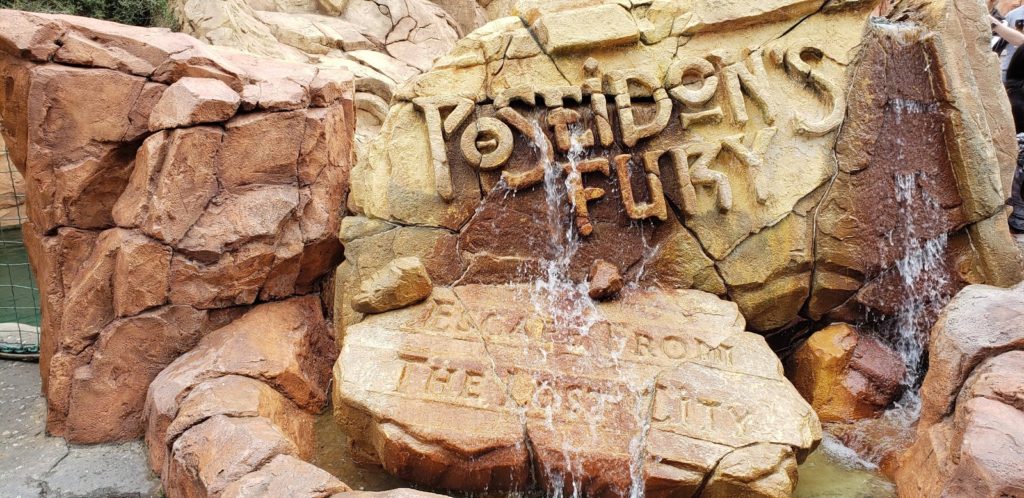
Promoted as a 21st century headliner of “the world’s most technologically advanced theme park,” Poseidon’s Fury promised a next generation original experience that would merge Disney-style storytelling, Universal’s special effects expertise, and iconic original characters. Industry insiders claimed Poseidon’s Fury would put Universal’s new park on the map… Then, it opened. Contrary to marketing, early visitors to Islands of Adventure found Poseidon’s Fury middling, confusing, and – oh no… – boring.
After two years of declining reviews, Poseidon was sunk… Or so it seemed… A quick (and cheap) fix by a prominent attraction designer is often cited with creating as many problems as it solved, completely reimagining the attraction’s plot and characters. Today, we’ll dive deep into the two versions of Poseidon’s Fury that have existed and leave it to you to decide if this sinking story is a legend or a disaster… and what should happen next.
And before we head off, remember that you can unlock rare concept art and audio streams in this story, access over 100 Extra Features, and recieve an annual Membership card and postcard art set in the mail by supporting this clickbait-free, in-depth, ad-free theme park storytelling site for as little as $2 / month! Become a Park Lore Member to join the story! Until then, let’s start at the beginning…
Backstage pass(ed)
As frequent readers of our Lost Legends entries know, the story of any theme park attraction tends to long before the first guests ever step through its doors. Ironically, the prologue to Poseidon’s Fury –like the attraction itself – is of a legendary battle between two all-powerful titans… but in this case, they’re media titans.
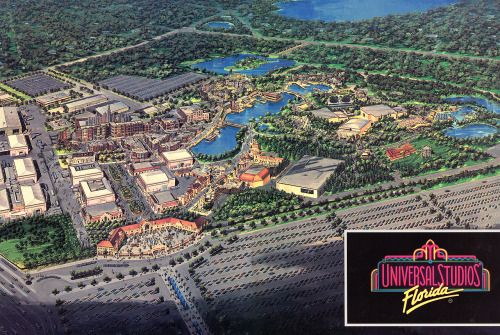
It’s no surprise to industry fans that the “war” between Disney and Universal has been an ongoing struggle for power since the 1980s. That’s when Universal began to get serious about plans for a “studio” themed park in Central Florida, activating Walt Disney World’s defenses as the two film industry giants raced to open their own movie-making parks.
Disney squeaked by a win, opening the Disney-MGM Studios in 1989, followed quickly by Universal Studios Florida in 1990 (followed by other studios jumping into the game, purchasing or constructing an era of “studio” themed amusement parks through the ‘90s).
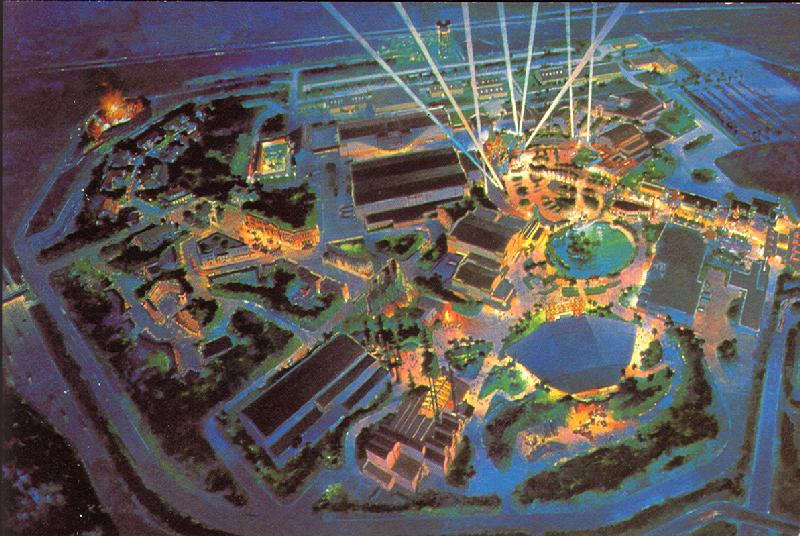
Say what you will about the two studio parks in Florida, but one thing is certain: neither has aged spectacularly well. With the sobering view of hindsight, we can see that “studio” themed parks pretty instantly dated themselves as relics of the ‘90s, with mis-matched intellectual properties, industrial “backlot” design, and beige soundstages acting as a creative (and budget-saving) cop-out. (It’s no accident that both of Orlando’s movie parks have pivoted to “immersive, cinematic” lands that let guests step into movies rather than going behind-the-scenes of them.)
It’s also why – less than a decade out from each studio park’s opening – both Disney and Universal were already hard at work designing follow-ups that would look entirely different.
A new era
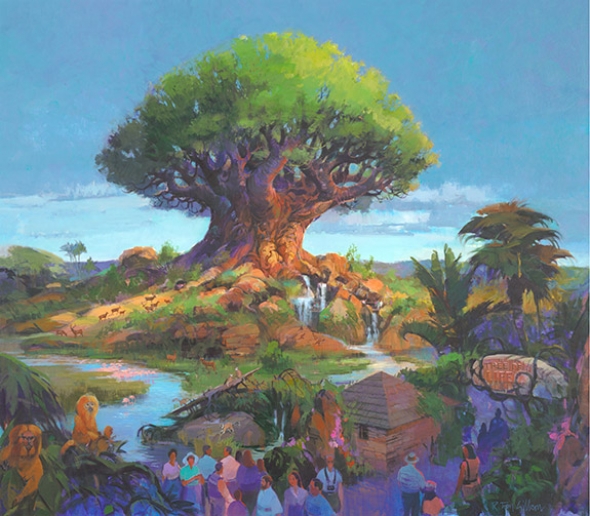
For Disney, the New Millennium would be marked by a new generation of themed design incarnate in Animal Kingdom – a park that dispensed entirely with seeing “behind-the-scenes” in favor of constructing hyperrealistic, immersive, natural worlds rich with detail. Animal Kingdom would be a park based on the universal themes of the intrinsic value of nature and transformation through adventure.
Universal, meanwhile, was quietly concepting a new kind of park all their own; one that would simultaneously solve Universal’s “not-enough-for-families” problem and take aim right at Disney’s bread-and-butter. Their unique “IP park” would’ve assembled themed lands dedicated to Looney Tunes, Batman and Superman, Jay Ward’s “Sunday funnies,” and the highly sought-after Dr. Seuss library into one park called Cartoon World.
When it came to Cartoon World, Universal had an ace up its sleeve: prominent creative designer (and former Disney Imagineer) Gary Goddard. Goddard had already topped the credits of two of Universal’s recent hits (the Lost Legends: Kongfrontation and Terminator 2: 3-D) and was actively at work on a third: Universal Studios Hollywood’s Jurassic Park: The Ride.
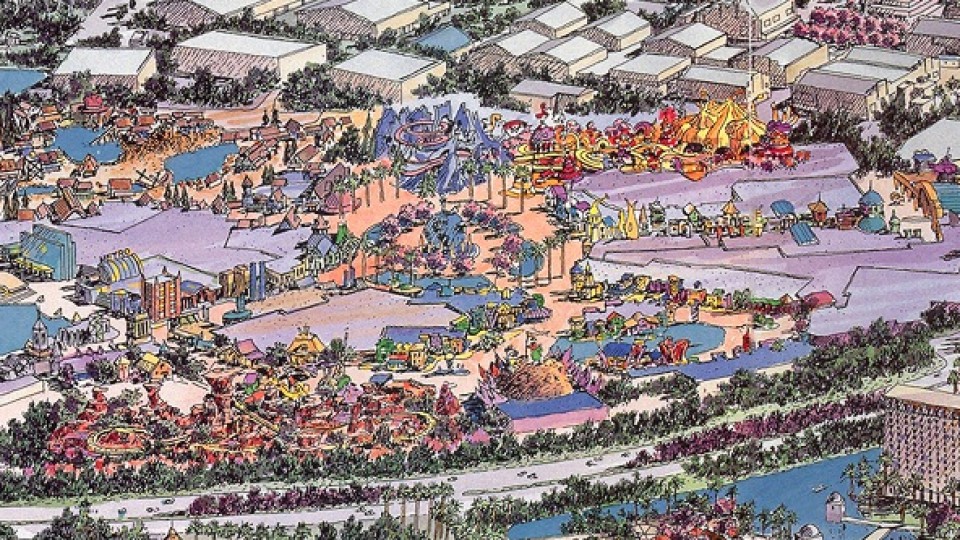
Put another way, things were changing quickly in the themed entertainment industry, and just as Joe Rohde was masterminding Disney’s response with Animal Kingdom, Gary Goddard and his Landmark Entertainment company were equally transformative in early plans for Cartoon World. (In fairness, we have to note that Goddard was the subject of sexual assault allegations in 2017 alongside frequent filmmaking collaborator and X-Men director Bryan Singer.)
Goddard and Landmark Entertainment had crafted substantial plans for Cartoon World – and in particular, its DC Superheroes and Looney Tunes areas) when negotiations with the properties’ owner, Warner Bros., allegedly fell apart. Cartoon World was quickly rewriting itself… and given that the axed agreement with Warner Bros. left no less than three blank spaces in the park’s lineup, plans began to change.
For one, a down-on-its-luck Marvel Comics stepped in and happily licensed its superhero characters to Universal in perpetuity (the subject of our must-read Special Feature, AVENGERS: Custody War), lending Goddard license to design a new ride based on Marvel’s Spider-Man…
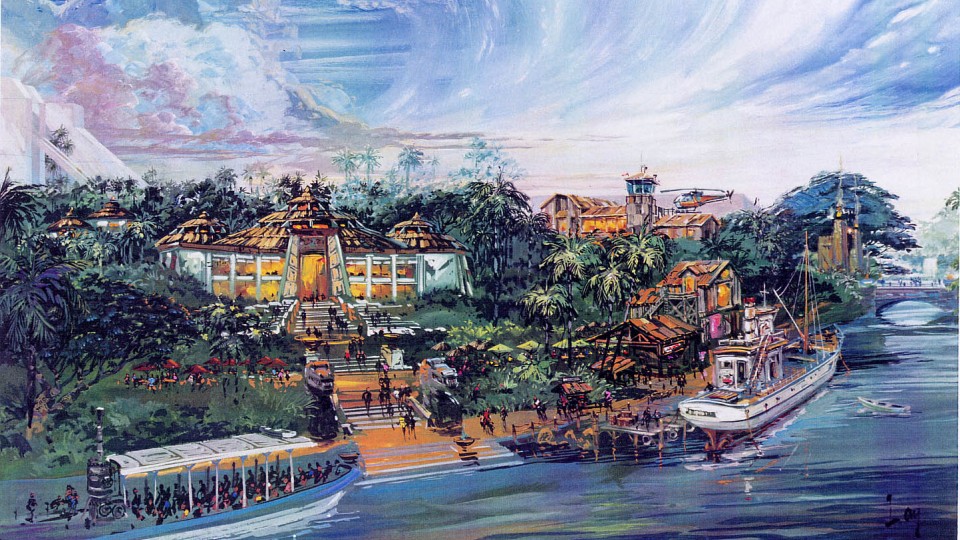
In a second vacated conceptual plot, the antipated success of Jurassic Park and Goddard’s boat ride in Hollywood spurred the decision to create an entire Jurassic Park land in Orlando, becoming the keystone and centerpiece of the new park.
And for the last vacant slot in the new park’s lineup? If you ask some industry insiders, they’ll say that what happened next was no coincidence; that when Disney decided to pull the plug on the Possibilityland: Beastly Kingdom once drafted for Disney’s Animal Kingdom, designers fed up with Disney’s budget-crunching and cost-cutting in the ’90s decided to take their plans elsewhere. Universal’s new park would get its own influx of imaginary creatures, myths, and legends…
Technology triumphs
Even as early as 1992, Universal’s designers were beginning to mold the new park, with its attraction lineup taking shape. One of the earliest versions of the attraction we know today as Poseidon’s Fury started then as Journey to Atlantis – an attraction that would’ve looked quite different. Literally. Guests journeying through the “myths and legends” land in the park would’ve stumbled across a gargantuan Atlantean drill having recently erupted up and broken through the earth. Massive scaffolds erected by archaeologists would allow guests to climb to the drill’s top and then descend into it.

Within, it’s believed that the attraction itself would’ve been somewhat like a “madhouse,” with guests seated in a nearly-stationary theater while a massive cylindrical room would rotate around them, likely designed as to make guests feel that they were indeed tunneling deep through the Earth’s crust and emerging in the ocean with views of the sunken city.
Of course, as the park continued to evolve and take shape, Journey to Atlantis changed, too. According to industry insiders, one of the main drivers of its redevelopment was the emergence of water screens (featured prominently in Disneyland’s Modern Marvel: Fantasmic, which premiered in 1992) and the French entertainment company ECA2, whose new rain screens could feature cinema-sized projects through water.
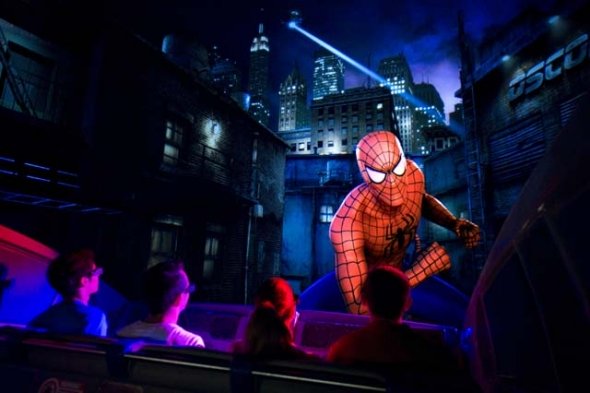
In fact, this is about when Universal made a smart pivot: to overtly recast the new park from a world of cartoons to something much bigger: “The World’s Most Technologically Advanced Theme Park.” Development of the new second gate would now center on featuring never-before-seen technologies pushing the industry forward. From the near-miss computer-powered Dueling Dragons to the interactive animatronics of the Triceratops Encounter and the headlining ride system behind Spider-Man, technology would be the unifying feature of this 21st century park – and like Disney’s best, it would all be hidden; embedded into immensely detailed environments.
And that went for Journey to Atlantis, too… By mixing a tried-and-true Universal special effects spectacular with the world’s largest installation of rain curtains and water screens, Universal could reposition a Journey to Atlantis attraction as a headlining technological marvel. Oh, and they’d found one last ingredient to bring it to the next level…
Technifex, an industry effects leader, was brought in to develop something big. The video above shows Technifex testing something unusual: a portal formed entirely of water blasted across the inside of a ring, with engineers able to pass through. Universal’s request? Turn the mere ring into a 40-foot long tunnel that guests could walk through.
The “Vortex” that would be the highlight of the attraction became Universal’s centering purpose for the show; the iconic element that would perfectly embed unthinkable technology in an ancient story. (Perhaps to its detriment… in fact, you might argue that the entire experience is built around the Vortex, so much so that the story to get there was a somewhat contrived way to force the experience in.) No matter; the tested concept revealed that, by blasting water at more than 100 miles per hour, the “Vortex” could indeed form around an 18-foot diameter tunnel… and that guests could even touch it (though the fast-moving water would instantly blast their hand away).
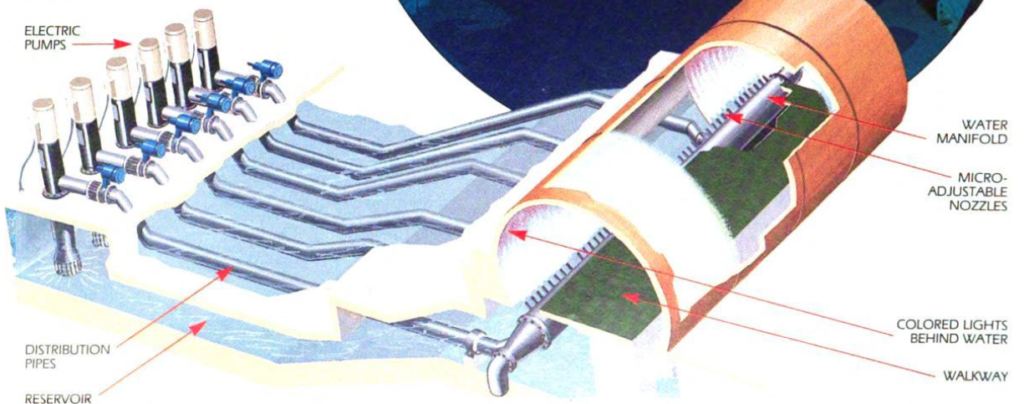
With a special effects show as its finale and the walkthrough water tunnel as the must-have technological highlight to get there, the new Journey to Atlantis evolved in concept to grow closer to the walkthrough attraction we know today. Now all they needed was a story to bring it all together… Read on…



I definitely agree with some of your points and not so much with others. Saying someone is “alleged [blank]” can ruin their life. But if they are exonerated, there’s never a headline about that. As the writer you absolutely have the choice to mention it. Regardless, thank you for your thoughtful response and I do not wish for this to distract from the great journalistic work here.
You mention that “in fairness” you should mention assault allegations against the creator. But it seems that “in fairness” allegations wouldn’t be mentioned at all.
I wouldn’t typically approve – much less respond – to a comment so far afield of the attraction or memories associated with it, but in this case, I figured I should.
I suppose it depends on whom you intend to be fair to. Yes, allegations are just allegations. But as a writer and storyteller, it’s important to me that we acknowledge those claims for several reasons.
For one, here at Park Lore, we believe people when they report being victims of sexual assault or abuse. Believing victims does not mean that alleged crimes shouldn’t be investigated or that the alleged perpetrator is guilty. With that said, it would be unfair to those who reported this alleged abuse – and indeed, any reader who’s been assaulted or abused – to simply “not mention” it. I guess I’m “woke” like that.
Second – and as an extreme example – Bill Cosby legally has no convictions for his alleged crimes; Jeffrey Epstein is unconvicted in his 2019 case; OJ Simpson wasn’t convicted in 1994. But of course, just “not mentioning” that “in fairness” to any one of them would be an outrageous oversight and journalistic omission in any sort of discussion of that entertainer’s life, work, and legacy. It’s not even “political” or taking a “position” on a hot button issue; it’s part of telling the complete story.
Finally, as a storyteller who generally prides himself on contextualizing the “bigger picture” of the industry and the creators who work on these attractions, it’s important to me that we’re able to intellectually and emotionally differentiate the works of art we love from the often flawed humans who bring it to life. As a tremendously pivotal figure in many attractions that have shaped me, I can’t not talk about Gary Goddard and his impact on the industry I love. But any story here that celebrates his ideas shouldn’t read like a deification or veneration of him as a person. Contextualizing the role of Goddard and his contributions requires acknowledging allegations that – “fair” or “unfair” – are a part of his story.
You (hopefully) came here for “in-depth, interconnected, and inclusive” theme park storytelling. That’s what I promised, and this is how I do it.